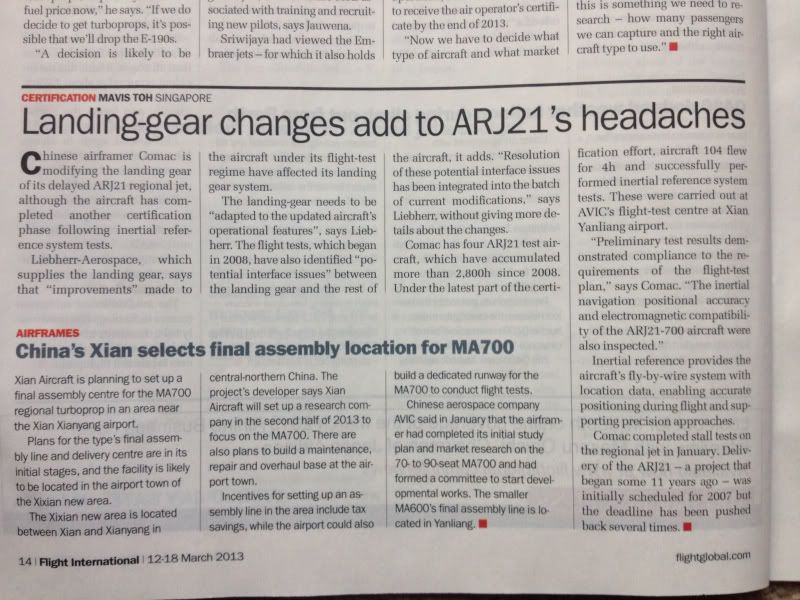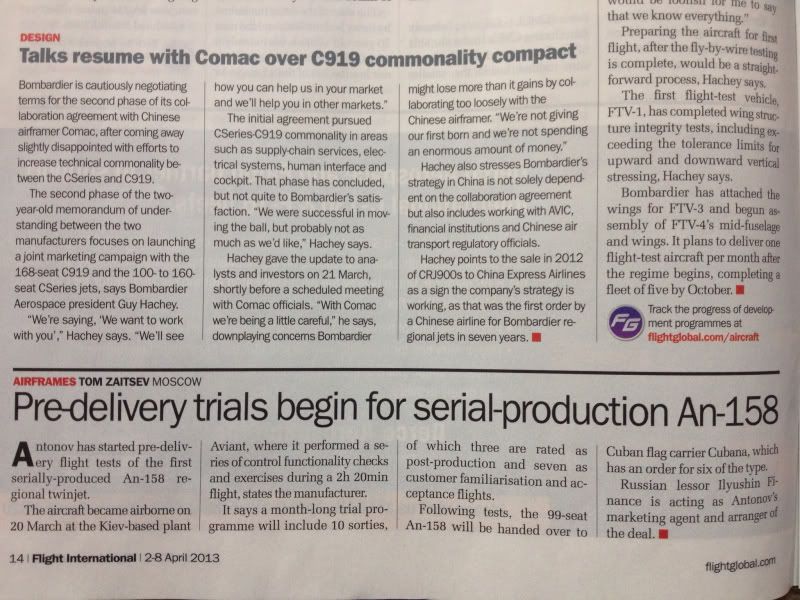You are using an out of date browser. It may not display this or other websites correctly.
You should upgrade or use an alternative browser.
You should upgrade or use an alternative browser.
Chinese Aviation Industry
- Thread starter FriedRiceNSpice
- Start date
asif iqbal
Lieutenant General
Some updates on the MA-700 an ARJ-21 from Flight International


asif iqbal
Lieutenant General
Updates on C919 and larger CS series Chinese aircraft


escobar
Brigadier
Just a bare three months after declaring it was ready to move ahead with a composite wing box, COMAC has abandoned major use of composite structures in the C919 airliner, claim industry executives familiar with the design.
Development of a composite wing box would have delayed the program, COMAC's managers reportedly decided, because it presented many complications, including the challenge of conducting electricity from lightning strikes, say two industry officials familiar with progress in the design. Expansion and contraction with temperature changes would have differed from the rest of the airframe, too. and so the center wing box will now be made from conventional aluminum, like the rest of the wing.
As recently as January, COMAC was working towards building the massive structure at the intersection of the wing and fuselage out of composite. It announced Jan. 18 that after a critical design review "the design of C919 composite [central wing] structure was evaluated finally and could proceed to the next phase."
Despite early ambitions, it now seems that the materials scheme of the C919 airframe will be little more advanced than that of the Airbus A320 and Boeing 737.
The fuselage could include some aluminium-lithium, a stronger but much more costly material. Industry executives familiar with the design believe it's notable that Comac has still not settled this issue, despite intending to fly the first prototype C919 in June 2014.
Moreover, materials experts working on the project doubt that COMAC is in a position to determine the characteristics of new aluminium alloys to the satisfaction of the certification agency, the Civil Aviation Administration of China, which itself probably lacks experience in the field. Suppliers might be able to help to some degree, however.
Composites will be widely used in the tail of the C919 and in its moveable structures, following a practice that has been widespread in Western aircraft since the 1980s.
In another sign of slow progress, nothing has been fitted to the C919 iron bird, the ground rig on which a new aircraft's equipment is mounted for static testing, a third industry official says.
All this recent news are signs of the youth and shallowness of China's industry, as well as technology transfer limits and sanctions having their intended effect. China will have to invest the dollars, time, and talent into R&D in the component industries that feed into the final product industries.
No surprises there. Even long time player like Boeing encounter problems with the Dreamliner while in operation. Of all things, one would expect the batteries would be the least of problems?
And they were subcontracted to a Japanese company.
escobar
Brigadier
COMAC will miss a target to fly its C919 158-seat narrowbody airliner in 2014, industry sources familiar with the Chinese program tell Aviation Week.
The first flight now is scheduled for the second quarter of 2015, says one industry source with detailed knowledge of the program. According to the new plan, COMAC will roll out the aircraft in December 2014, says the source.The manufacturer still is aiming to achieve its target of a first delivery in 2016 - but only just. The specific aim is now December of that year.
The first flight has been delayed by up to a year from a previous, unannounced target of June 2014. Program managers had scheduled at least two years for flight testing. They now have about 18 months for testing, closer to the time allocated for flight tests by Western manufacturers.
The C919's new schedule more closely matches the timetable for its engine. The CFM Leap-1C engine is due to be certified in June 2015, although the Civil Aviation Administration of China could permit C919 flight testing before the engine is certified.
The first Leap-1C should go into testing in the fall of this year, or at least no later than the fourth quarter. COMAC, a government agency registered as a company, made the decision to reschedule months ago, say three industry sources. The delay is no surprise. The C919, launched in 2008, began to miss schedule targets as early as the supplier selection and contracting stage.
One program manager later acknowledged that COMAC simply was inexperienced in that process, despite having gone through it about six years earlier with its ARJ21 regional jet. Industry sources close to the program remain skeptical about the new target; suppliers also are known to be expecting first deliveries in 2018, not 2016.
A strong sign that things were not going well emerged in April when it was revealed that COMAC had switched the material for the center wing box, the structural heart of the aircraft, from carbon-fiber composite to aluminum.
Industry sources at the time said the change was made because the manufacturer saw too much risk in building the composite part. Another industry source now says that the problem was that the composite center wing box, built with foreign help, would have cost too much.
To some extent COMAC was ready for the change, because early in its program it decided to develop aluminum alternatives to composite parts. Development of the aluminum center wing box should have been well advanced when the decision to use it was made.
asif iqbal
Lieutenant General
China should really have a lot of experience in this field, so far they have built over 126 Airbus A320 aircraft from thier Airbus assembly line in Tianjin
The building of the Airbus really put China on the right track as far as commercial aircraft goes, somehow however things haven't gone quite according to plan
Never the less they must push on, invest more and try harder to get the issues resolved, even if it means delaying the project, they have to master this field of technology no matter what the cost is there is a big market for ARJ-21 and C919 and COMAC is a young company
The building of the Airbus really put China on the right track as far as commercial aircraft goes, somehow however things haven't gone quite according to plan
Never the less they must push on, invest more and try harder to get the issues resolved, even if it means delaying the project, they have to master this field of technology no matter what the cost is there is a big market for ARJ-21 and C919 and COMAC is a young company
